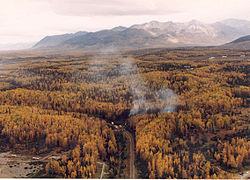 Aerial view of the crash site | |
| Accident | |
|---|---|
| Date | September 22, 1995 |
| Summary | Bird strike on takeoff |
| Site | Near Elmendorf Air Force Base, Alaska, United States 61°15′57″N149°45′39″W / 61.26583°N 149.76083°W |
 | |
| Aircraft | |
 77-0356, sister ship to the accident aircraft involved | |
| Aircraft type | Boeing E-3B Sentry |
| Operator | United States Air Force |
| Call sign | YUKLA 27 |
| Registration | 77-0354 |
| Flight origin | Elmendorf Air Force Base, Alaska, United States |
| Destination | Elmendorf Air Force Base, Alaska, United States |
| Occupants | 24 |
| Crew | 24 [1] |
| Fatalities | 24 |
| Survivors | 0 |
The Alaska Boeing E-3 Sentry accident was the September 22, 1995 crash of a United States Air Force Boeing E-3 Sentry airborne early warning aircraft with the loss of all 24 crewmembers on board. [2] The aircraft, serial number 77-0354 with callsign Yukla 27, hit birds on departure from Elmendorf Air Force Base in Alaska, United States. With the loss of thrust from both of the left engines, the aircraft crashed into a wooded area less than a mile from the end of the runway. [1]


